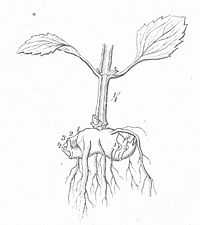Scrophularia nodosa
| Scrophularia nodosa | |
|---|---|
 | |
| Scientific classification | |
| Kingdom: | Plantae |
| (unranked): | Angiosperms |
| (unranked): | Eudicots |
| (unranked): | Asterids |
| Order: | Lamiales |
| Family: | Scrophulariaceae |
| Genus: | Scrophularia |
| Species: | S. nodosa |
| Binomial name | |
| Scrophularia nodosa L. | |
Scrophularia nodosa (also called figwort, woodland figwort, and common figwort) is a perennial herbaceous plant found in temperate regions of the Northern hemisphere except western North America.[1] It grows in moist and cultivated waste ground.[2]
Growth
It grows upright, with thick, sharply square, succulent stems up to 150 cm tall from a horizontal rootstock. Its leaves are opposite, ovate at the base and lanceolate at the tip, all having toothed margins. The flowers are in loose cymes in oblong or pyramidal panicles. The individual flowers are globular, with five green sepals encircling green or purple petals, giving way to an egg-shaped seed capsule.[3]

Folklore
The plant was thought, by the doctrine of signatures to be able to cure the throat disease scrofula because of the throat-like shape of its flowers.[4]
References
- ↑ Mills, S., The Complete Guide to Modern Herbalism, Thorsons, Great Britain, 1994.
- ↑ PLANTS Profile for Scrophularia nodosa (woodland figwort) | USDA PLANTS
- ↑ Figwort
- ↑ Figwort: Free Encyclopedia Articles at Questia.com Online Library
External links
| Wikimedia Commons has media related to Scrophularia nodosa. |
- Scrophularia.—Carpenter's Square. | Henriette's Herbal Homepage
- Scrophularia Nodosa - Homeopathic Remedies